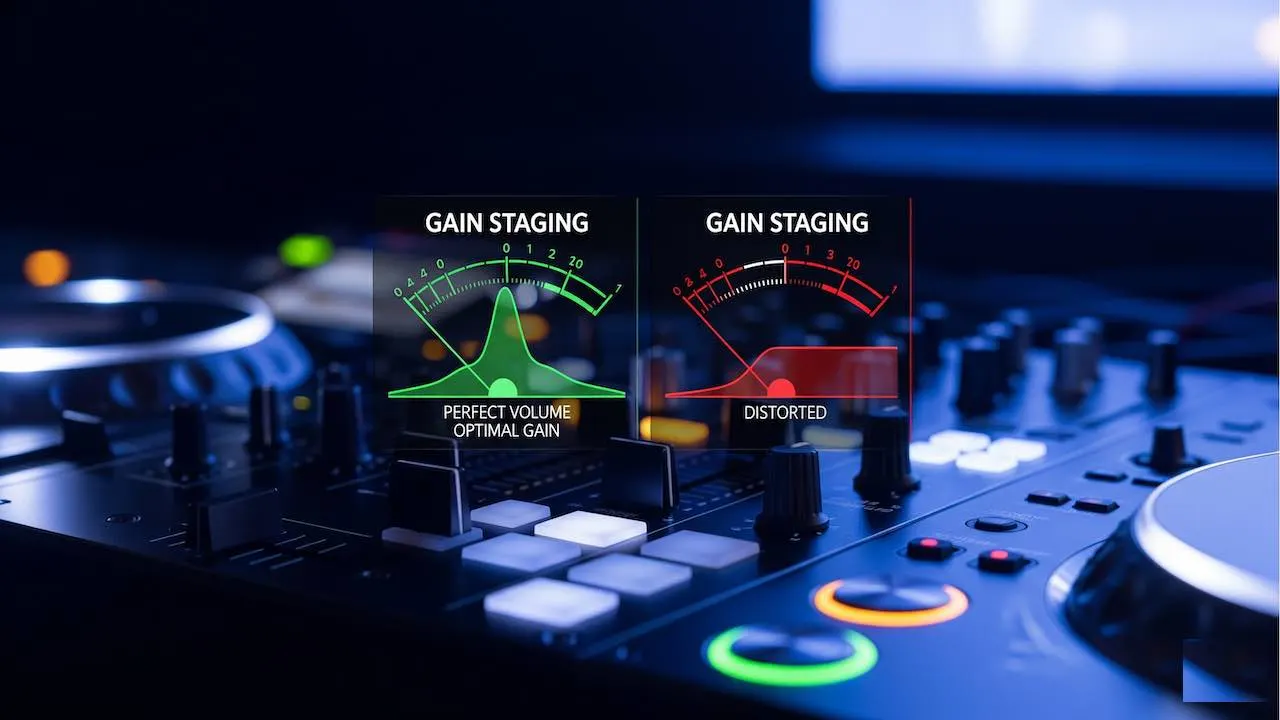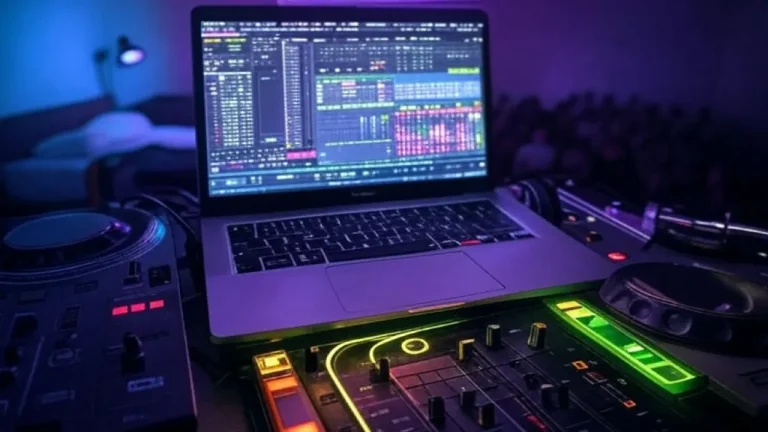Professional DJ gain staging involves setting optimal signal levels at each point in your audio chain to achieve maximum clarity without distortion. Proper gain staging prevents distortion, ensures consistency across tracks, and maximizes the signal-to-noise ratio by keeping levels around 0dB with peaks hitting into the orange range.
Club sound engineers depend on DJs who understand gain structure. When you master these techniques, your sets sound cleaner, louder, and more professional while protecting expensive venue equipment from damage.
Understanding DJ Gain Structure Fundamentals
Gain structure controls the signal strength at every stage of your audio pathway. Each channel on your DJ gear features a gain knob located above the EQ section, which alters the signal level for that specific channel.
The signal chain flows from your music source through these stages:
- Track input gain (channel gain knobs)
- Channel faders and EQ controls
- Crossfader and master fader
- Master output to club amplifiers
- Amplifier gain to speaker systems
Each stage must receive the optimal signal level to prevent distortion and maintain audio quality. Sound technicians hate when DJs play in the red because professional systems are gain-staged during setup to have ideal sound quality when the DJ mixer hits right before the red zone.
Setting Perfect Input Gain Levels
Start with all gain controls turned completely down before beginning your set. Play a track at its loudest point, then adjust the input gain on each channel so the average volume reaches 0dB, which typically shows as the top green LED on your channel meters.
Follow this step-by-step process for each track:
- Load your track and find the loudest section (usually the drop or chorus)
- Set channel faders to unity position (12 o’clock or 0dB marking)
- Slowly increase the gain knob while watching your channel meters
- Stop when the meters consistently show green with occasional orange peaks
- Never allow sustained red peaks, which indicate clipping distortion
| Meter Color | Signal Level | Action Required |
|---|---|---|
| Green | Optimal range | Perfect – maintain this level |
| Orange/Yellow | Hot but acceptable | Occasional peaks are fine |
| Red | Clipping/distortion | Reduce gain immediately |
Master Output and Club System Integration
Your master output level determines how your signal interfaces with the club’s sound system. Professional DJ software like Serato provides both individual deck meters and master gain controls affecting all outputs equally, showing levels just before signals reach your hardware.
Club venues typically expect these output standards:
- Master output peaking around +4dBu for line-level connections
- Consistent signal levels across all tracks in your set
- Clean signals without digital clipping or analog distortion
- Headroom for dynamic range and unexpected volume spikes
Sound engineers configure their amplifiers expecting properly gain-staged signals from DJ mixers. When you send clipped or inconsistent levels, it forces them to compensate with their equipment, often resulting in compromised sound quality for your entire performance.
Advanced Gain Staging Techniques for Professional Sets
Professional DJs use multiple techniques to maintain perfect levels throughout their sets. These methods help you handle tracks with varying loudness levels and maintain consistent energy on the dancefloor.
Track Preparation and Analysis
Analyze your tracks before performing to identify their optimal gain settings. Most DJ software provides waveform analysis showing track dynamics and peak levels. Use this information to preset your gain knobs for smooth performance.
Create gain maps for your track library, noting which songs require higher or lower input gain. This preparation prevents sudden volume jumps that can damage speakers or hurt dancers’ ears.
Real-Time Level Management
Monitor your levels constantly during performance. Aim for your music to average around the 0dB mark with certain peaks hitting into the orange range, going down the chain of audio devices to find the maximum level before clipping.
Use these live adjustment techniques:
- Micro-adjust gain knobs between tracks to match levels
- Use channel EQ to control frequency-specific loudness
- Monitor both channel and master meters simultaneously
- Keep consistent headroom for unexpected bass drops or vocal peaks
| Performance Scenario | Gain Strategy | Expected Outcome |
|---|---|---|
| Track transitions | Match input gains before mixing | Seamless volume consistency |
| Bass-heavy drops | Leave 3dB headroom on low frequencies | Clean bass without distortion |
| Vocal-centric tracks | Boost mid-range clarity at input stage | Clear vocals over instrumental |
Common Gain Staging Mistakes to Avoid
New DJs often make critical errors that compromise their sound quality and damage venue equipment. Understanding these mistakes helps you develop professional-level gain management skills.
The most damaging mistake involves pushing all controls to maximum, thinking louder equals better. This approach creates multiple stages of clipping, resulting in harsh distortion that sounds terrible and can destroy expensive club speakers.
Avoid these common pitfalls:
- Setting gain knobs to maximum and adjusting volume with faders only
- Ignoring meter readings and mixing by ear alone in loud club environments
- Using EQ controls to compensate for poor gain structure
- Failing to account for track-to-track volume differences
- Pushing master outputs beyond optimal levels for perceived loudness
Professional sound engineers can immediately identify DJs with poor gain discipline. Your reputation in the club scene depends heavily on your technical competence and respect for venue equipment.
Equipment-Specific Gain Management
Different DJ equipment requires specific approaches to gain staging. Understanding your gear’s characteristics helps you optimize signal flow and achieve professional results in any venue.
Pioneer CDJ and DJM Series
Industry-standard setups featuring Pioneer DJM mixers like the A-9, V10, or DJM-900NXS2 remain popular in professional venues. These mixers provide precise metering and gain controls designed for optimal club integration.
Pioneer equipment typically features:
- Individual channel gain knobs with detented unity positions
- High-resolution LED meters showing precise signal levels
- Master output controls calibrated for professional amplifier interfaces
- Built-in limiters to prevent accidental clipping damage
Software-Based DJ Systems
Modern DJ software provides multiple gain control options including track gain, track compressors, and master limiters for balancing volume across your mix. These digital tools offer precision impossible with analog-only systems.
Software advantages include:
- Visual waveform analysis for gain optimization
- Automatic gain matching between tracks
- Digital meters with precise dB readings
- Recall of previous gain settings for familiar tracks
However, software systems require understanding of digital vs. analog gain principles. Digital clipping sounds harsher than analog saturation, making proper gain staging even more critical.
Troubleshooting Club Sound System Issues
Professional DJs must quickly identify and resolve gain-related problems during live performances. Sound issues can ruin your set and damage your professional reputation if not addressed immediately.
Common symptoms and solutions include:
Distorted bass frequencies: Usually indicates excessive low-frequency gain at the input stage. Reduce channel gain and use EQ to control bass levels rather than input clipping.
Weak overall volume despite maximum settings: Suggests improper gain structure where early clipping prevents clean signal amplification. Start over with conservative gain settings and build up systematically.
Inconsistent levels between tracks: Points to lack of gain preparation and real-time monitoring. Use software analysis tools and prepare gain maps for your track library.
Always communicate with venue sound engineers about persistent issues. They understand their system’s characteristics and can provide guidance specific to that club’s setup.
Professional Development and Best Practices
Mastering gain staging requires consistent practice and continuous learning. Professional DJs invest time understanding audio engineering principles that directly impact their performance quality.
Study these related topics to improve your technical skills:
- EQ Basics Mix Pro for frequency-specific gain management
- Intermediate EQ Techniques for advanced signal processing
- DJ Gear Setup Optimize Workflow for equipment configuration
Professional development includes:
- Practicing with different equipment types and venues
- Learning from experienced sound engineers and veteran DJs
- Understanding basic audio engineering principles
- Keeping current with new technology and industry standards
Your technical competence directly affects your bookings and career progression. Club promoters and venue managers notice DJs who consistently deliver clean, professional sound without requiring sound engineer intervention.
People Also Ask
The ideal gain level averages around 0dB with occasional peaks reaching into the orange zone. This provides optimal signal-to-noise ratio while maintaining headroom for dynamic content and preventing distortion.
Prevent clipping by setting conservative input gain levels and monitoring meters constantly. Keep average levels in the green range with brief orange peaks acceptable, but never allow sustained red readings indicating distortion.
Use channel gains to optimize each track’s input level, then use master volume for overall output control. This approach maintains clean signal path and prevents multiple stages of amplification that can introduce noise and distortion.
Club distortion often results from improper gain staging that pushes venue amplifiers beyond their clean operating range. Home systems have different amplifier characteristics and may mask clipping that becomes obvious on powerful club sound systems.
Analyze tracks beforehand to identify their optimal gain settings and create preparation notes. Use software tools to visualize track dynamics and preset your gain knobs for smooth transitions without sudden volume changes.
Low gain settings reduce signal-to-noise ratio and may require excessive amplifier gain that introduces system noise. While safer than clipping, insufficient gain levels compromise audio quality and may sound weak compared to properly gain-staged signals.







